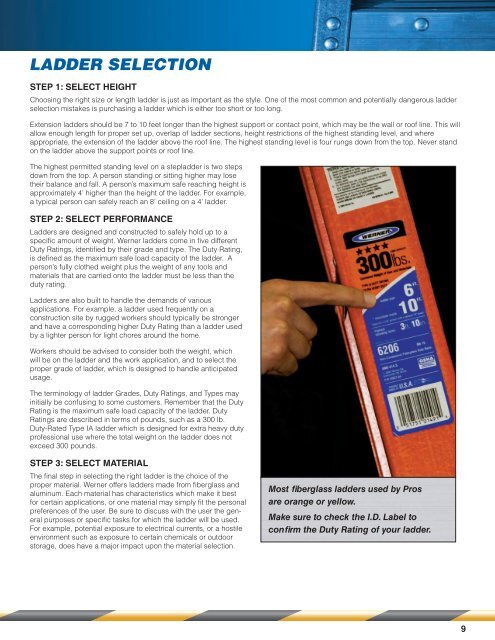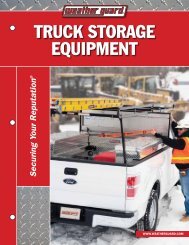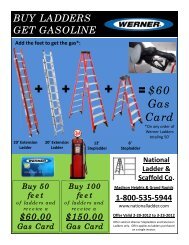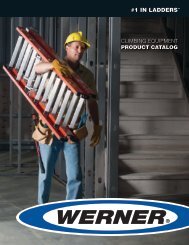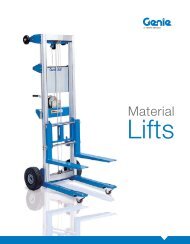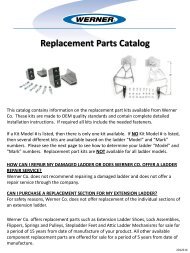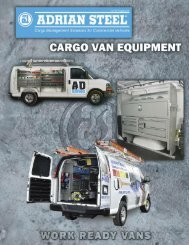LADDER SAFETY V3 - National Ladder and Scaffold Co.
LADDER SAFETY V3 - National Ladder and Scaffold Co.
LADDER SAFETY V3 - National Ladder and Scaffold Co.
You also want an ePaper? Increase the reach of your titles
YUMPU automatically turns print PDFs into web optimized ePapers that Google loves.
<strong>LADDER</strong> SELECTIONSTEP 1: SELECT HEIGHTChoosing the right size or length ladder is just as important as the style. One of the most common <strong>and</strong> potentially dangerous ladderselection mistakes is purchasing a ladder which is either too short or too long.Extension ladders should be 7 to 10 feet longer than the highest support or contact point, which may be the wall or roof line. This willallow enough length for proper set up, overlap of ladder sections, height restrictions of the highest st<strong>and</strong>ing level, <strong>and</strong> whereappropriate, the extension of the ladder above the roof line. The highest st<strong>and</strong>ing level is four rungs down from the top. Never st<strong>and</strong>on the ladder above the support points or roof line.The highest permitted st<strong>and</strong>ing level on a stepladder is two stepsdown from the top. A person st<strong>and</strong>ing or sitting higher may losetheir balance <strong>and</strong> fall. A person’s maximum safe reaching height isapproximately 4’ higher than the height of the ladder. For example,a typical person can safely reach an 8’ ceiling on a 4’ ladder.STEP 2: SELECT PERFORMANCE<strong>Ladder</strong>s are designed <strong>and</strong> constructed to safely hold up to aspecific amount of weight. Werner ladders come in five differentDuty Ratings, identified by their grade <strong>and</strong> type. The Duty Rating,is defined as the maximum safe load capacity of the ladder. Aperson’s fully clothed weight plus the weight of any tools <strong>and</strong>materials that are carried onto the ladder must be less than theduty rating.<strong>Ladder</strong>s are also built to h<strong>and</strong>le the dem<strong>and</strong>s of variousapplications. For example, a ladder used frequently on aconstruction site by rugged workers should typically be stronger<strong>and</strong> have a corresponding higher Duty Rating than a ladder usedby a lighter person for light chores around the home.Workers should be advised to consider both the weight, whichwill be on the ladder <strong>and</strong> the work application, <strong>and</strong> to select theproper grade of ladder, which is designed to h<strong>and</strong>le anticipatedusage.The terminology of ladder Grades, Duty Ratings, <strong>and</strong> Types mayinitially be confusing to some customers. Remember that the DutyRating is the maximum safe load capacity of the ladder. DutyRatings are described in terms of pounds, such as a 300 lb.Duty-Rated Type IA ladder which is designed for extra heavy dutyprofessional use where the total weight on the ladder does notexceed 300 pounds.STEP 3: SELECT MATERIALThe final step in selecting the right ladder is the choice of theproper material. Werner offers ladders made from fiberglass <strong>and</strong>aluminum. Each material has characteristics which make it bestfor certain applications, or one material may simply fit the personalpreferences of the user. Be sure to discuss with the user the generalpurposes or specific tasks for which the ladder will be used.For example, potential exposure to electrical currents, or a hostileenvironment such as exposure to certain chemicals or outdoorstorage, does have a major impact upon the material selection.Most fiberglass ladders used by Prosare orange or yellow.Make sure to check the I.D. Label toconfirm the Duty Rating of your ladder.9


